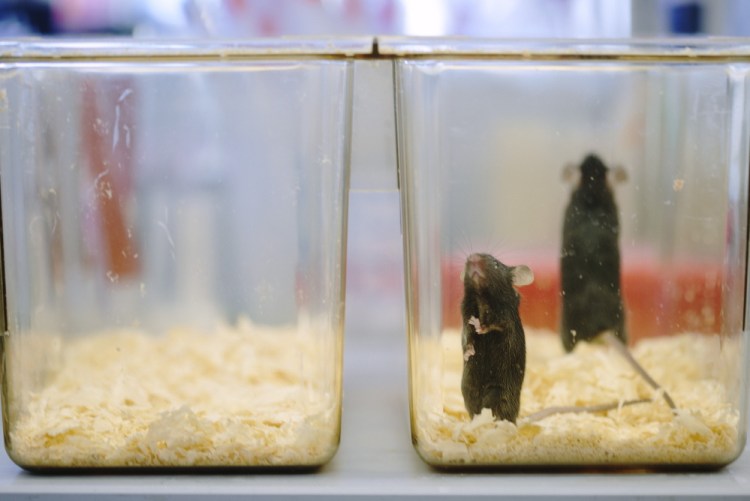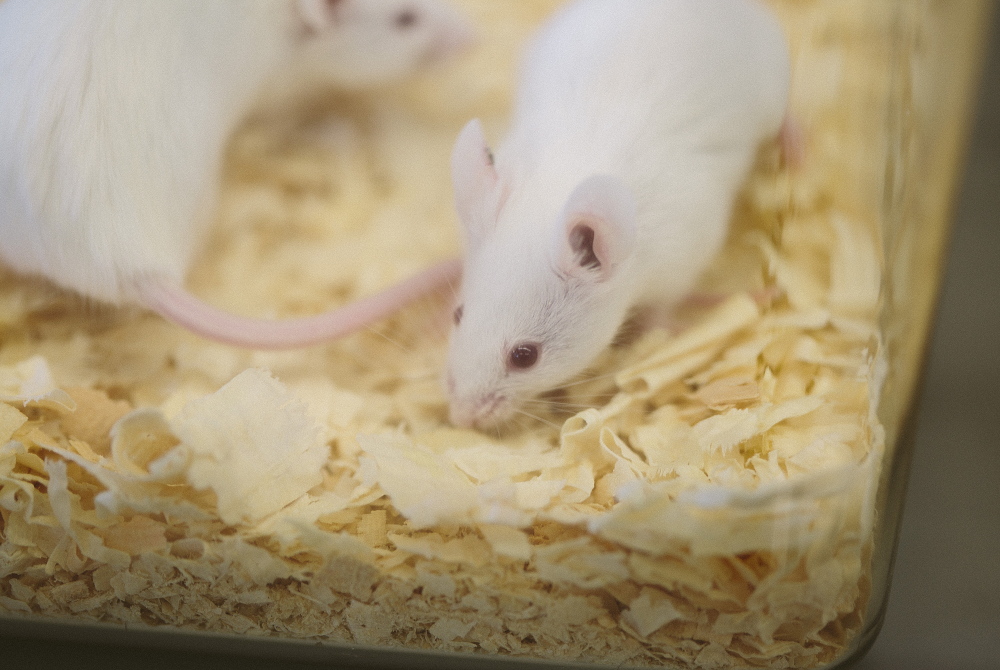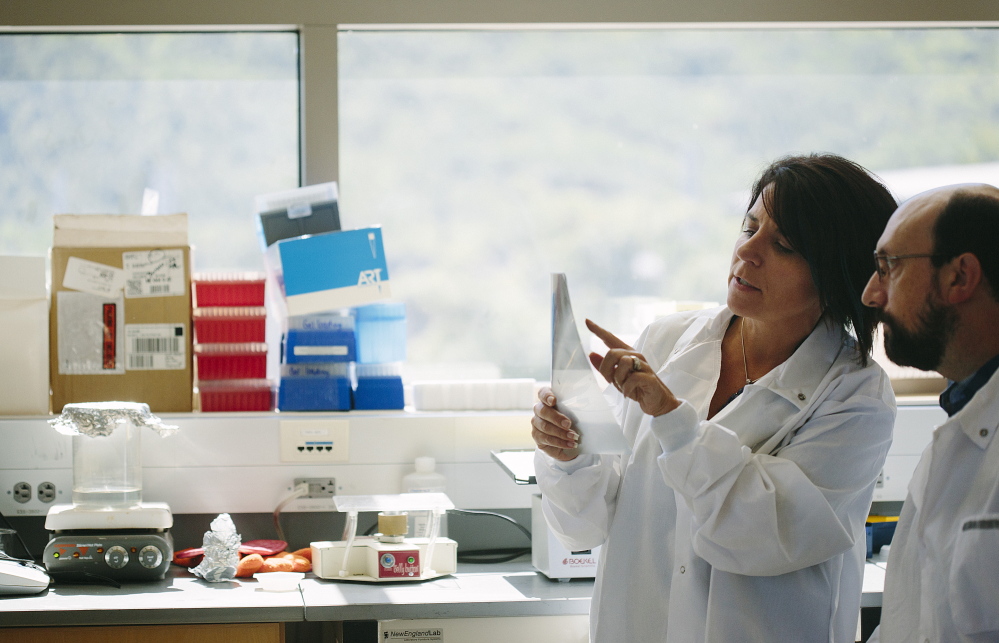The Ice Bucket Challenge soaked heads and raised goosebumps, but once the fundraising fad dies down, the end result will be a surge of cold, hard cash for scientists, including researchers in northern New England.
Jackson Laboratory in Bar Harbor will likely ramp up production of research mice genetically engineered to develop ALS because of the success of the Ice Bucket Challenge. The lab distributes thousands of mice with ALS each year to about 200 research facilities around the world, and lab scientists say demand for the mice could double, depending on how money raised by the viral video campaign is allocated.
In just a few weeks, the campaign has raised more than $100 million for the ALS Association to support efforts to stop the crippling disease, dwarfing the $20 million or so usually raised by the charity each year. Participants have dumped buckets of ice on their heads, donated to the cause and challenged others to do the same. Even former President George W. Bush has taken the challenge.
The ALS Association hasn’t decided yet what to do with the money, but a chunk of it will go toward research. Scientists at Jackson Lab, as well as in New Hampshire and Vermont, say they are anticipating a windfall in ALS research dollars.
The nonprofit Jackson Lab also does its own research on ALS, and could gain funding to accelerate and expand that work. Other northern New England research facilities that could benefit include Dartmouth-Hitchcock Medical Center in Lebanon, New Hampshire, and Fletcher Allen Health Care in Burlington, Vermont.
“ALS research is in its infancy right now. It’s like trying to do a puzzle with only a couple of pieces revealed,” said Dr. Cat Lutz, director of the Rare and Orphan Disease Center at Jackson Lab.
Amy Kuzma, chapter director of the ALS Association of Northern New England, said it’s too early to say how the money will be spent, but much of it will be awarded to research facilities. Of about $19.4 million raised in 2012, the most recent year for which tax filings are available, the national office reported giving about $6 million in scientific grants.
“We need to determine the best way to invest in this support,” said Kuzma, noting that the ALS Association spends in ways that help improve the lives of ALS patients.
The Ice Bucket Challenge has caused a frenzy of activity at the ALS Association, and more people are becoming aware of the disease, Kuzma said. Hopefully, she said, the movement will have staying power because of increased awareness.
“About 50 percent (of the U.S. population) had heard of ALS before the Ice Bucket Challenge, and we believe that number has grown,” Kuzma said. “It’s just been phenomenal. We are completely overwhelmed by the support.”
Amyotrophic lateral sclerosis is a fatal neurodegenerative disease, also known as Lou Gehrig’s disease, that slowly paralyzes its victims. Those diagnosed with ALS often live fewer than five years, according to the U.S. Centers for Disease Control and Prevention. About 5,000 people are diagnosed with ALS every year, according to the ALS Association.
MANY CAUSES, FEW SOLUTIONS
Jackson Lab produces about 2 million mice per year. Providing thousands more ALS mice for scientists might seem like small numbers in comparison, but for ALS research it would be a significant boost in resources, scientists say.
Dr. Greg Cox, also a researcher at Jackson Lab, said ALS is a “tough disease” to study. The causes are unknown, and no one knows how it can be prevented. Treatments have done little to extend lives.
“ALS isn’t one disease caused by one thing,” Cox said. “There are many different forms of ALS.”
Jackson Lab’s mice are genetically mutated to develop ALS. There are now more than 40 “mouse models” – types of mice with ALS – that can be sold to research facilities. Lutz said additional research money will help the lab develop more mouse models, to give scientists more tools to work with.
Lutz said she works on creating mouse models that are consistent – which are more useful for researchers – and on ways to more quickly provide lab mice for new research.
“We can develop mouse models in three months instead of the 18 months it used to take,” Lutz said. “The barrier of time and expense has dropped.”
Lutz and Cox are studying genetic causes of ALS. It’s thought that about 5 percent to 10 percent of ALS cases are caused by faulty genes; research might reveal more genetic causes. Also, some people with genetic predispositions to ALS might contract the disease after an environmental trigger, such as exposure to certain toxins, Cox said.
In addition to the money raised by the Ice Bucket Challenge, Jackson Lab is applying to the National Institutes of Health to be considered for a formal relationship with research facilities across the country that are studying ALS. Through the partnership, the lab would receive reports on DNA sequences of people who have ALS and would then alter the genetics of mice to mirror the ALS patients. They would study which mice then go on to develop ALS, which will help determine genetic causes of ALS.
While some researchers are doing the genetic comparisons, Cox said it’s “hit or miss” rather than a standard procedure. The goal, he said, is to have DNA sequencing of ALS patients become common practice.
A BOOST FOR RESEARCH UNDERWAY
Other prominent ALS research facilities in the region include Dartmouth-Hitchcock and Fletcher Allen Health Care.
The two facilities are working together on studies of whether people who are exposed to blue-green algae blooms are more likely to get the disease. Scientists at both facilities say they’re excited about the potential for more ALS research.
“It’s a very healthy, hopeful scene,” said Dr. Elijah Strommel, a neurology professor at Dartmouth College who works on ALS research for the medical center.
“The more money is poured into this, the more chances we have for improvements in therapies.”
Strommel said that while Ice Bucket Challenge funding is welcome, he’s also concerned about continued cutbacks by the federal government to the National Institutes of Health, which has lost $1.5 billion in annual funding, with its budget reduced from $31.5 billion to $30 billion since 2010.
That has resulted in fewer research grants, although it’s unclear how those cutbacks would specifically affect ALS research. The U.S. Defense Department also researches ALS because veterans, for unknown reasons, are more likely to contract the disease, Kuzma said.
Strommel has been studying the possible ALS connection with algae blooms for several years, after noticing a high number of ALS cases near Lake Mascoma in Enfield, New Hampshire, which has a lot of blue-green algae blooms. The research has expanded to Florida, to areas with high levels of algae blooms. Dr. Rup Tandan, a principal investigator of ALS at Fletcher Allen, who is working on the blue-green algae research with Dr. Strommel, also studies nutrition and ALS.
“The caloric needs of patients with ALS increase substantially,” Tandan said.
Tandan said he’s found that while ALS patients need many more calories than a typical person for a variety of reasons, including the paralyzing effects of the disease on chewing and swallowing, simply eating more and improving diet is not effective.
Tandan has developed an injection – similar to an insulin injection for diabetics – that delivers needed nutrition and calories to patients.
While Fletcher Allen has been successful in obtaining funding for ALS research, like most scientists they’ve also been rejected many times due to insufficient funding.
Tandan said he’s looking forward to fewer rejections as the ALS Association distributes its grants.
“I believe this will really propel the research forward,” he said.
Send questions/comments to the editors.







Comments are no longer available on this story